 Corrosion can cause damage to metal components of a building.
Corrosion can cause damage to metal components of a building.Selecting Corrosion-resistant and Anti-graffiti Coatings
FMs should understand the fundamentals of these coatings to make the best choice.
For anti-corrosive (corrosion-resistant) coatings, protecting the substrate is paramount to prevent conditions similar to those shown in the picture above. If the finish coat fails or the paint film is breached, then the primer must protect the substrate temporarily until the finish coat can be repaired. Corrosion-resistant coatings are very important to substrate protection because, regardless of location (coastal, rural, urban, etc.), we are surrounded by conditions that support corrosion — some conditions being more corrosive than others. Depending on geographic location, the atmosphere can contain different corrosive chemicals. When these chemicals mix with atmospheric or surface moisture, aggressive compounds that are corrosive to various substrates, such as concrete, metals, and wood, are formed by these mixtures.
NACE (National Association of Corrosion Engineers) defines corrosion as the deterioration of a substance, usually a metal, or its properties because of a reaction to its environment. Physics says corrosion is the process of a metal returning to its natural oxide state. In other words, corrosion occurs when a metal is exposed to an environment or condition that it should not be exposed to. Isolating the metal or substrate from unacceptable conditions will usually prevent corrosion. That is where the proper protective (corrosion-resistant) coating comes in.
Primers and finish coats must be compatible with each other and be able to resist the ambient conditions that they are exposed to. First, the primer must be matched to the substrate and must perform dual roles. Unless the finish coat is self-priming, the primer creates a base for the finish coat and protects the substrate if the finish coat is compromised. Epoxies are a common corrosion-resistant primer. Because of the galvanic protection properties of hot-dipped galvanizing and galvalume, they are often used as primers for high performance coatings, such as epoxy, powder coatings, and polyvinylidene difluoride (PVDF). Galvalume and galvanized metal can be left uncoated in certain environments; but, before doing so, determine exposure conditions and refer to the product data sheets for exposure recommendations and exclusions such as urban, rural, coastal, and industrial locations.
Anti-corrosive coatings are marketed by most of the trade sales paint and coating manufacturers. Information in the product data sheets for a particular coating will include recommended uses for that coating, the primer for various substrates, application instructions, and chemical resistance data.
For a more detailed discussion of corrosion and its prevention, please refer to Reference 5 listed at the end of this article.
Anti-graffiti coatings
Anti-graffiti coatings are formulated to allow easy removal of the type graphic art shown below without damaging the substrate. These coatings are usually produced by specialty manufacturers; however several of the major trade sales paint and coating manufacturers market anti-graffiti coatings, too. There are two types of anti-graffiti coatings — sacrificial and permanent.
• Sacrificial anti-graffiti coating is really a clear finish coat (usually single component) that is applied over the color coat to create a clear protective coat similar to the clear coat on an automobile finish. When graffiti is written over the clear coat, the clear coat is removed along with the graffiti by pressure washing or hand scrubbing. This leaves the color coat clean and intact. Hence, a sacrificial coating. Sacrificial coatings are non-yellowing acrylic and contain a release agent that makes them easy to remove. Initially, sacrificial anti-graffiti coatings are usually more economical than permanent anti-graffiti coatings. However, after cleaning and applying another sacrificial coat, initial cost benefits may be sacrificed.
• Permanent anti-graffiti coatings are a combination color and anti-graffiti coating, are often water-base, and are intended to be applied once. Permanent coatings are usually abrasion-resistant, non-yellowing, and weather-resistant, and act as a release agent, preventing graffiti from adhering permanently. Some coatings require graffiti to be removed by strong solvents or with a special graffiti remover provided by the anti-graffiti coating manufacturer. Removing the graffiti does not normally harm permanent graffiti, which can withstand repeated cleaning.
Related Topics:















